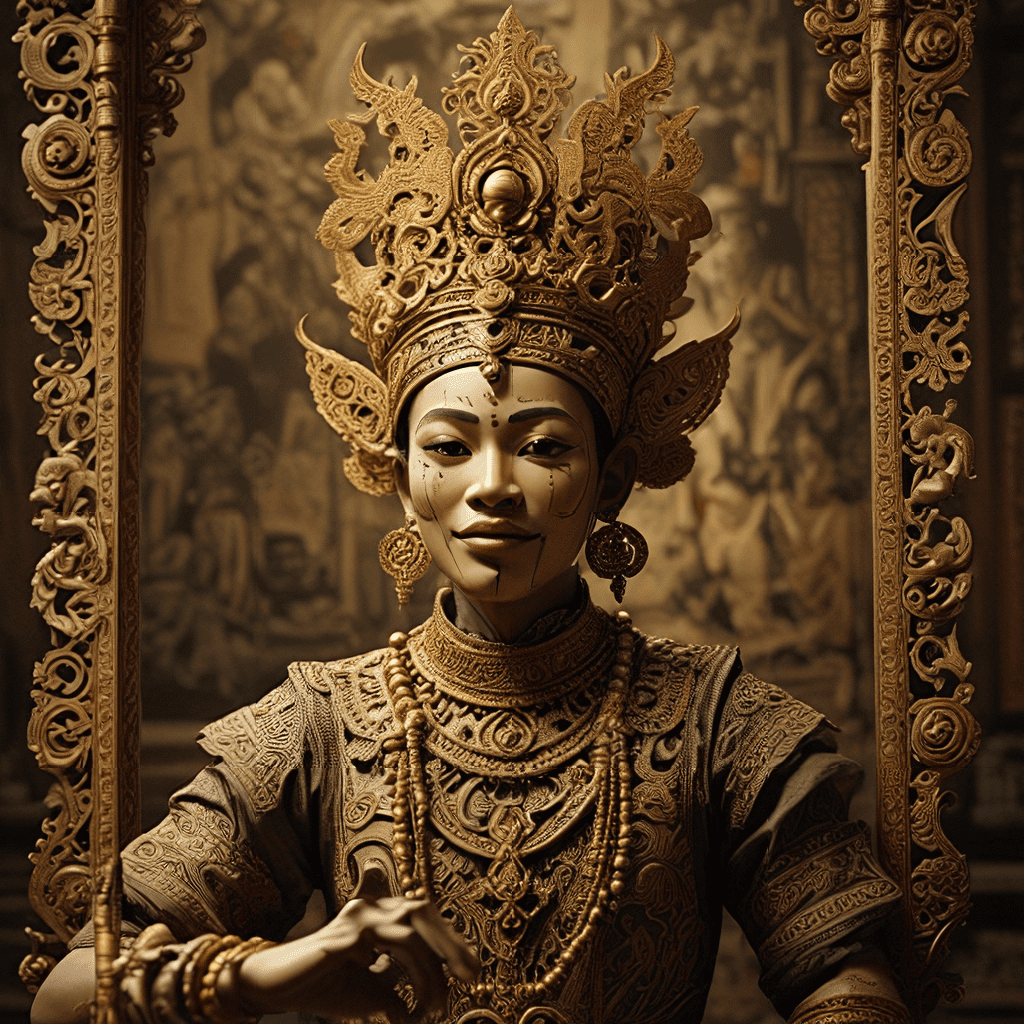Wayang Kulit: A Window into Indonesian Mythology
Wayang kulit, the traditional shadow puppet theatre of Indonesia, is more than just a form of entertainment. It is a vibrant window into the rich tapestry of Indonesian mythology, offering a glimpse into the beliefs, values, and cultural heritage of its people.
The Origins of Wayang Kulit: A Reflection of Ancient Indonesian Beliefs
The roots of wayang kulit are deeply intertwined with the ancient beliefs and practices of the Indonesian archipelago. It is believed that the earliest forms of puppetry emerged from animistic rituals where puppets were used to communicate with spirits and ancestors. These rituals, often performed during agricultural cycles or important life events, played a crucial role in maintaining harmony between the human world and the spiritual realm.
As Hinduism and Buddhism spread through Indonesia, they influenced the development of wayang kulit. The stories of the Hindu epics, the Ramayana and the Mahabharata, became central to the performances, providing a framework for exploring themes of good versus evil, duty and responsibility, and the search for spiritual enlightenment.
The Gods and Goddesses of Wayang Kulit: A Pantheon of Mythical Beings
The world of wayang kulit is populated by a vast pantheon of deities, mythical beings, and legendary heroes. Each character possesses unique powers, personalities, and stories, reflecting the diverse beliefs and cultural traditions of Indonesia.
The central figure in many wayang kulit stories is Batara Guru, the king of the gods, who embodies wisdom, justice, and cosmic order. His consort, Dewi Uma, is known for her strength and compassion. Other notable deities include Batara Wisnu, the preserver of the universe, and Batara Brahma, the creator god.
Mythical creatures like the giant Garuda, the legendary bird-man, and the mischievous spirits known as "kera" (monkeys) add further dimensions to the world of wayang kulit.
The Central Role of the Shadow Play: A Medium for Storytelling and Ritual
The signature element of wayang kulit is the use of shadow puppets, which are crafted from intricately carved leather. The puppets are manipulated by a puppeteer, known as a "dalang," who uses a lamp to project their shadows onto a white screen. The dalang is not simply a storyteller but also a musician, a singer, and a master of ceremonies, weaving together ancient tales with witty dialogue, musical interludes, and improvisational flourishes.
The use of shadow play creates a unique and evocative experience. The shadows dance and flicker, bringing the characters to life in a way that transcends the physical world. The darkness of the screen symbolizes the unknown, the mysterious, and the spiritual realm, while the light of the lamp represents knowledge, understanding, and enlightenment.
The Moral and Ethical Teachings of Wayang Kulit: Lessons for Life
Beyond their entertainment value, wayang kulit plays a crucial role in transmitting moral and ethical teachings to audiences of all ages. The stories often address universal themes of good and evil, duty and responsibility, love and loss, and the search for meaning in life.
Through the actions and interactions of the characters, wayang kulit explores concepts of dharma (righteousness), karma (the law of cause and effect), and moksha (spiritual liberation). The performances serve as a reminder of the importance of living a virtuous life, upholding ethical principles, and striving for spiritual enlightenment.
The Connection Between Wayang Kulit and the Natural World: Harmony and Balance
Wayang kulit is not just a collection of stories; it's a reflection of the deep connection Indonesians have with their natural environment. The characters and their stories are often linked to elements of nature, highlighting the importance of harmony and balance in the world.
For example, the giant Garuda, the mythical bird-man, represents the power and majesty of the sky. His quest for knowledge and freedom mirrors the human desire to explore and understand the mysteries of the universe. The mischievous kera (monkeys) embody the playful and unpredictable nature of the forest, reminding us of the interconnectedness of all living things.
The rhythms and melodies of the gamelan orchestra, which accompanies wayang kulit performances, often evoke the sounds of nature, including the rustling of leaves, the chirping of birds, and the flow of water. Through these elements, wayang kulit teaches audiences to appreciate and respect the natural world, highlighting its intricate balance and the importance of maintaining harmony with it.
The Role of Wayang Kulit in Social and Political Life: A Tool for Communication and Control
Wayang kulit has long been a vital part of Indonesian social and political life. During the colonial era, it was used by the Dutch to spread their messages and control the population. However, Indonesian rulers also used wayang kulit as a tool for communication, education, and entertainment.
The performances served as platforms for discussing social issues, promoting ethical behavior, and highlighting the importance of community values. Through allegorical stories, the dalang could subtly convey messages about leadership, justice, and the need for social cohesion.
In modern times, wayang kulit continues to play an important role in Indonesian society. It is often used to educate children about their cultural heritage, promoting national pride and a sense of shared identity. The performances also serve as forums for community gatherings, fostering a sense of belonging and connection.
The Enduring Legacy of Wayang Kulit: A Cultural Treasure
Despite the challenges of globalization and modernization, wayang kulit continues to thrive in Indonesia. It is a vital part of the country's cultural heritage, recognized by UNESCO as an intangible cultural heritage.
The performances are a source of pride for Indonesians, and they continue to inspire artists, writers, and musicians. Wayang kulit characters are often featured in contemporary art, literature, and film, demonstrating the enduring influence of this ancient tradition on modern Indonesian culture.
Theories on the Evolution of Wayang Kulit: From Ritual to Entertainment
While the origins of wayang kulit are shrouded in mystery, scholars believe that it evolved from ancient animistic rituals, where puppets were used to communicate with spirits and ancestors. Over time, these rituals transformed into a form of entertainment, incorporating elements of Hindu and Buddhist mythology.
The introduction of Islam in Indonesia influenced the development of wayang kulit, with some stories incorporating Islamic themes. However, the core elements of the tradition, including the use of shadow puppets, the gamelan orchestra, and the skillful artistry of the dalang, have remained largely unchanged.
The Influence of Wayang Kulit on Other Art Forms: A Catalyst for Creativity
Wayang kulit has had a profound impact on other art forms in Indonesia, inspiring artists, writers, and musicians across generations. The characters, stories, and themes of wayang kulit have been reinterpreted in various mediums, including painting, sculpture, literature, and film.
The intricate designs of the shadow puppets have influenced textile patterns, jewelry, and other forms of decorative art. The rich musical tradition of wayang kulit, with its complex rhythms and melodies, has inspired composers and musicians, contributing to the development of Indonesian music.
FAQ:
Q: What is the difference between Wayang Kulit and Wayang Golek?
A: Wayang kulit uses shadow puppets made from leather, while Wayang Golek uses three-dimensional puppets made from wood.
Q: What is the role of the dalang in a Wayang Kulit performance?
A: The dalang is the puppeteer, storyteller, musician, and master of ceremonies. They manipulate the puppets, narrate the story, sing, play instruments, and interact with the audience.
Q: What are some of the important themes explored in Wayang Kulit stories?
A: Some important themes include good vs. evil, duty and responsibility, karma, and the search for spiritual enlightenment.
Q: Is Wayang Kulit still popular in Indonesia today?
A: Yes, Wayang Kulit remains a popular art form in Indonesia, and it is often used to educate children about their cultural heritage and promote community gatherings.




